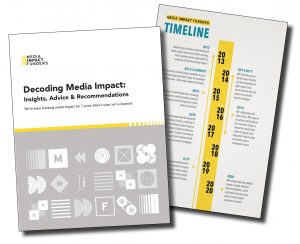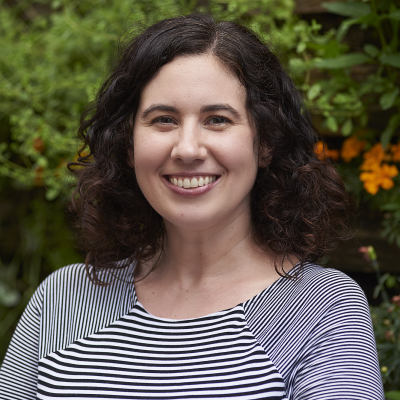
This year was slated to be our year of impact.
We started off with a bang in January at the Sundance Film Festival, where we released Decoding Media Impact: Insights, Advice and Recommendations, our impact report summing up seven years of research in the media impact space.
 Our years of research led us to these four key insights:
Our years of research led us to these four key insights:
- There are many different frameworks for measuring media impact for different areas of practice.
- Funders should be mindful of power dynamics, and thoughtful in determining appropriate impact strategies with their grantees.
- Digital analytics tools provide a wealth of useful data, but grantees require financial and logistical support in implementing them.
- There are opportunities for funders to collaborate with each other to share best practices and increase collective impact.
Our goal was to further interrogate these insights, and take the momentum from gatherings we’d held about the report and use it to inform a new impact strategy that addressed these key concerns, while bringing more voices into the conversation in a structured way.
In February, we traveled to the Frank conference at the University of Florida, where we learned all about how emotions influence media impact, expanding our perspective about what it means to tell powerful stories through media.
Then the pandemic hit.
Along with all of the other rapid changes brought about by the pandemic, we found that funders were shifting their perspectives on impact evaluation. Some eased off requiring extensive reporting and, in some cases, granted emergency funds without reporting or evaluation requirements.
At the same time, we saw a shift in the impact production space, where in-person gatherings and on-the-ground community work were suddenly off the table, forcing filmmakers and impact producers to get creative about distribution and community engagement. For example, we heard from Participant Media and Doc Society about how they pivoted and implemented new interventions for the pandemic. For a funder perspective, we talked with Denae Peters, a program officer with the Perspective Fund, who posed a series of important questions for funders in the impact production space to consider.
Over the summer, as the country erupted in a long-overdue reckoning over racial injustice, we took a closer look at the role of equity in evaluation, forcing us to examine the ways in which traditional impact evaluation practices have upheld oppressive structures.
Along the way, we highlighted innovative impact strategies addressing topics such as climate change, gun violence, science education, and early childhood education.
In reflecting on our conversations with stakeholders in the field over the entirety of the year, it’s clear we have a lot of questions left to answer. Here’s what we’d like to address in 2021:
- How do we move toward a shared definition of media impact among different types of funders? There are vast differences among types of funders and their goals as well as the projects they fund and how they conceptualize impact. For example, impact might look very different to a large foundation with multiple evaluation frameworks and the ability to hire academic research centers than it does to a small family foundation with no staff at all. While resources available for impact assessment may differ substantially, the way we talk about impact has to be accessible to everyone along this spectrum.
- How can we bridge the gaps between different areas of practice? As we’ve noted before, there are also differences in practice areas, particularly in how the impact space has evolved differently in the documentary film and journalism fields. But media is increasingly cross-platform and more difficult to break down into discrete silos. We must be able to think about impact as it pertains to narrative film, television, documentary film, games, apps, service journalism, advocacy journalism, various print media—and more. There are certainly distinct, field-specific considerations, particularly in the journalism space. However, at the same time, funders should also not get too caught up in the preferred metrics of one particular industry.
- How can we collaborate as funders to better understand collective impact? In our conversations with funders over the years, we’ve learned that there is no singular impact tool or framework that will work for every funder and every grant. However, there are many points of overlap. For funders who are supporting similar projects and issues, how can we open up more of a dialogue to better understand how we are collectively moving the needle?
- How can we make sure that equity is a core part of impact evaluation processes? What values are implicit in current evaluation processes? More and more, funders are seeing how equity is a crucial element of impact assessment. Funders must be aware of the dynamics inherent in traditional evaluation practices, and what it means for communities on the ground. In the media impact space, there are additional dynamics to consider: who is telling the story? Who is the subject? Who is given the power to evaluate and judge? What are the ethical considerations for all involved?
- For funders who already fund impact work, how can we build trust with grantees to encourage frank and honest conversations about impact and support those willing to experiment with new models and tools? We are seeing a rise in trust-based philanthropy, partially as a result of the pandemic, which lends itself to more open conversations around impact. Let’s be honest: The system as it is currently constructed encourages grantees to tell the best story they can in order to secure future funding. It does not, in general, encourage frank discussions about failures with room to pivot, learn, and grow, which is what is needed to actually implement effective impact strategies.
- How can funders move beyond surface-level engagement metrics and prioritize more meaningful forms of measurement and evaluation? In large part, we’ve seen funders move away from cookie-cutter metrics and toward more meaningful forms of evaluation. But this is not yet the case across the field—how can funders determine which metrics really matter depending on the goals of each individual project, grantee, and foundation?
- What is the appropriate role for impact tracking tools? A few years ago, we saw the development of many innovative tools, frameworks and dashboards in the media impact space. These tools serve a valuable purpose, particularly when it comes to helping funders and grantees sharpen their thinking in terms of what kinds of questions to ask and what data to collect. But lately we’ve seen less of an emphasis on creating new tools for grantees to adopt. This may not be a bad thing. Instead of coalescing around particular tools, funders can think deeply about what kinds of questions to ask that can cut across all different types of media, as well as different types of funders with existing internal frameworks and theories of change.
- How can we draw new funders into this space and capitalize on the growing awareness of the power of storytelling and narrative change? This is our key task for 2021: bringing more funders into the impact conversation. We hope you will join us on the journey.
